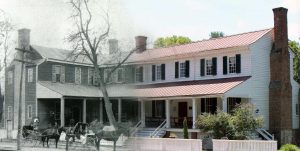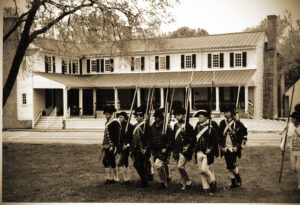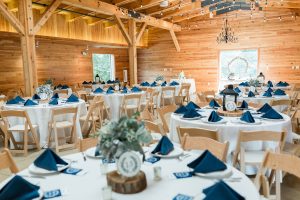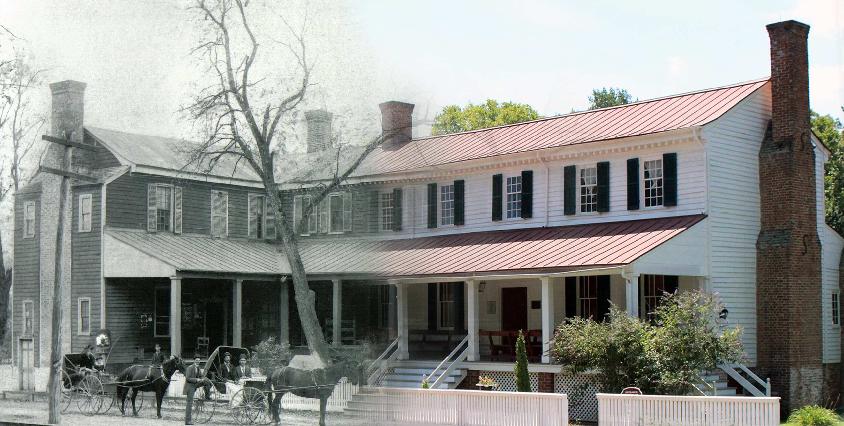History of Hanover Tavern

During the 18th and 19th centuries, Hanover County Court convened once per month, with judges and patrons traveling long distances to conduct business. Travelers needed an inn to provide meeting space, food, drink, and overnight stay as well as stables and food for the teams, horses, and mules.
Over the years, there have been just 2 inns associated with the 600-plus acre Hanover Tavern tract at Hanover Courthouse. The first, built in the 1750’s served colonial travelers, locals, and those that came for court day. This was a large business enterprise consisting of the tavern building, wh
ich was 2,300 square feet plus a basement, with a separate kitchen building, a separate house, as well as a barn, and a stable.
Hanover County’s greatest native son, Patrick Henry, married Sarah Shelton, the daughter of John & Eleanor Parks Shelton, the owners of the Tavern Tract from 1750 – 1764. Henry assisted his father-in-law by greeting and serving guests, tending bar, and entertaining with his fiddle playing and warm personality. Working at the tavern exposed Henry to the legal world and in April 1760 at the age of 24, he obtained a license to practice law.
A commander in Rochambeau’s French army described the road into Hanover Courthouse and closed by saying that “there is a very fine and large inn” there. In 1781 the Marquis de Chastellux wrote that Hanover Tavern was “a tolerably handsome inn, with a large salon and a covered portico.” Owned by Paul Thilman during the Revolution, Hanover Tavern hosted many well-known actors of this historic era: Patrick Henry, George Washington, the Marquis de Lafayette, and General Cornwallis to name a few.
inn” there. In 1781 the Marquis de Chastellux wrote that Hanover Tavern was “a tolerably handsome inn, with a large salon and a covered portico.” Owned by Paul Thilman during the Revolution, Hanover Tavern hosted many well-known actors of this historic era: Patrick Henry, George Washington, the Marquis de Lafayette, and General Cornwallis to name a few.
By the 2nd decade of the 19th century, tax records indicate that the original Tavern was in a declining condition and a decision was made to build a new Tavern. Set adjacent to the tavern owner’s 1791 home, the new building is “L” shaped with a portion jutting south and a part jutting to the east.
 After moving into the new tavern building, the original building was probably torn down. Around 1832, a section was built between the new Tavern and the home to tie them into one large building. The porches on both sides of the building were soon added. The owner at that time was William W. Thilman and his wife Eugenia. His grandfather, Paul Thilman Sr., was the owner of the original Tavern during the Revolution. This three-part building is the Tavern building that is present today.
After moving into the new tavern building, the original building was probably torn down. Around 1832, a section was built between the new Tavern and the home to tie them into one large building. The porches on both sides of the building were soon added. The owner at that time was William W. Thilman and his wife Eugenia. His grandfather, Paul Thilman Sr., was the owner of the original Tavern during the Revolution. This three-part building is the Tavern building that is present today.
The Civil War turned the Tavern into a home for refugees, fleeing the Union Army. One such boarder was Margaret Wight and her husband John. While living at the Tavern, Margaret kept a diary, reporting on such things as news of the war, worries about her children, occurrences at the Tavern, and the price of food and clothing. In the opening paragraph of the diary, Margaret refers to the war as “this most unhappy contest, which is now at its height, between the two sections of our once happy country”. Both Union and Confederate troops made numerous stops at the Tavern during the four years of the war.
In 1800, seven enslaved men from Hanover Tavern took part in the planning of a failed slave insurrection known as Gabriel’s Rebellion. Over the years, celebrated guests such as Chief Justice John Marshall, Edgar Allen Poe, P.T. Barnum, Charles Dickens, Union General Fitz John Porter, and Confederate generals J.E.B. Stuart and Wade Hampton visited this roadside fixture on the corridor between Richmond and Fredericksburg.
 By 1953, the tavern building was well-worn and possibly on its last legs. A group of young actors from New York bought the building with the intention of starting a dinner theater. They repaired the building to operate as their home and business, actually beginning the preservation of the old structure. Barksdale Theatre (now Virginia Repertory Theatre) was born and remains today a valuable part of the history of Hanover Tavern.
By 1953, the tavern building was well-worn and possibly on its last legs. A group of young actors from New York bought the building with the intention of starting a dinner theater. They repaired the building to operate as their home and business, actually beginning the preservation of the old structure. Barksdale Theatre (now Virginia Repertory Theatre) was born and remains today a valuable part of the history of Hanover Tavern.
Hanover Tavern Foundation, a 501 (c) (3) nonprofit organization, bought the Tavern in 1990 with the mission to restore, preserve, and utilize Hanover Tavern as an historical, educational, community and cultural resource center. The Foundation raised over $5 million, stabilizing and restoring the historic building, added a wing for restrooms, a restaurant quality kitchen, new mechanical systems, and refurbished the theater. The building returned to public use in 2005.
 The E. J. Wade Coach House education, meeting, and event space was opened to the public in June 2015, representing an investment of about $1.2 million.
The E. J. Wade Coach House education, meeting, and event space was opened to the public in June 2015, representing an investment of about $1.2 million.
Today, this cultural site offers student field trips, educational history programs, historical exhibits, heritage musical events, lecture series, and family-oriented special events as well as a full-service restaurant and pub, meeting, wedding, party, and events space, and Virginia Repertory Theatre performances in a modern 150 seat theater.




